The floor-standing brain function monitor market is valued at USD 126.9 million in 2025. Demand for floor-standing brain function monitors is projected to reach USD 233.8 million by 2035, advancing at a 6.3% CAGR as hospitals, neurosurgical centers, and diagnostic facilities increase investments in precision monitoring systems. Growth through 2025–2030 lifts the market to USD 162.1 million, adding USD 35.2 million and capturing nearly one-third of the decade’s total value creation. This period is marked by the rapid uptake of single-modal optimization monitors, which command 55% share, driven by their diagnostic reliability, optimized signal quality, and compatibility with existing clinical setups. The expansion accelerates in 2030–2035, where the market adds USD 71.7 million, supported by rising adoption of multimodal fusion platforms and advanced clinical integration across high-volume neurological facilities.
Clinical diagnosis applications contribute approximately 60% of total demand, reflecting strong utilization in routine patient evaluation, neurological screening, and hospital-based diagnostic programs. Intraoperative monitoring applications hold a 35% share, driven by neurosurgery and complex spinal procedures requiring real-time precision assessment. Asia Pacific emerges as a decisive growth engine, led by China at 8.5% CAGR and India at 7.9% CAGR, while Germany (7.2%), Brazil (6.6%), and the United States (6%) maintain strong adoption momentum across established healthcare networks. Competitive leadership remains concentrated among Natus, Medicom MTD Ltd, NeuroWave Systems Inc., and Neurosoft, each strengthening its portfolio through improved signal processing, automated diagnostic integration, and clinical workflow compatibility.

The latter half (2030-2035) will witness sustained growth from USD 162.1 million to USD 233.8 million, representing an addition of USD 71.7 million or 67.1% of the decade's expansion. This period will be defined by mass market penetration of specialized multimodal monitoring designs, integration with comprehensive clinical platforms, and seamless compatibility with existing neurological monitoring infrastructure. The market trajectory signals fundamental shifts in how healthcare providers approach neurological assessment optimization and diagnostic quality management, with participants positioned to benefit from sustained demand across multiple monitoring modalities and clinical application segments.
The Floor-standing Brain Function Monitor market demonstrates distinct growth phases with varying market characteristics and competitive dynamics. Between 2025 and 2030, the market progresses through its technology adoption phase, expanding from USD 126.9 million to USD 162.1 million with steady annual increments averaging 6.3% growth. This period showcases the transition from basic monitoring formulations to advanced single-modal optimization systems with enhanced diagnostic capabilities and integrated quality control systems becoming mainstream features.
The 2025-2030 phase adds USD 35.2 million to market value, representing 32.9% of total decade expansion. Market maturation factors include standardization of neurological monitoring and clinical diagnostic protocols, declining component costs for specialized monitoring formulations, and increasing healthcare awareness of brain function assessment benefits reaching optimal diagnostic effectiveness in clinical and surgical applications. Competitive landscape evolution during this period features established medical device manufacturers like Natus and Medicom MTD expanding their brain monitoring portfolios while specialty manufacturers focus on advanced modality development and enhanced diagnostic capabilities.
From 2030 to 2035, market dynamics shift toward advanced multimodal integration and global healthcare expansion, with growth continuing from USD 162.1 million to USD 233.8 million, adding USD 71.7 million or 67.1% of total expansion. This phase transition centers on specialized monitoring systems, integration with automated clinical networks, and deployment across diverse diagnostic and surgical scenarios, becoming standard rather than specialized applications. The competitive environment matures with focus shifting from basic monitoring capability to comprehensive diagnostic optimization systems and integration with patient care monitoring platforms.
At-a-Glance Metrics
| Metric | Value |
|---|---|
| Market Value (2025) | USD 126.9 million |
| Market Forecast (2035) | USD 233.8 million |
| Growth Rate | 6.3% CAGR |
| Leading Technology | Single-modal Optimization Type Monitoring Modality |
| Primary Application | Clinical Diagnosis Application Segment |
The market demonstrates strong fundamentals with single-modal optimization systems capturing a dominant share through advanced monitoring design and diagnostic optimization capabilities. Clinical diagnosis applications drive primary demand, supported by increasing neurological assessment requirements and precision monitoring technology needs. Geographic expansion remains concentrated in developed markets with established healthcare infrastructure, while emerging economies show accelerating adoption rates driven by neurological care expansion and rising diagnostic standards.
Market expansion rests on three fundamental shifts driving adoption across the clinical diagnosis, intraoperative monitoring, and specialized neurological care sectors. First, neurological diagnostic demand creates compelling operational advantages through floor-standing brain function monitors that provide immediate assessment precision and patient evaluation without compromising care quality goals, enabling healthcare providers to meet stringent diagnostic standards while maintaining clinical productivity and reducing misdiagnosis risks. Second, healthcare infrastructure modernization accelerates as medical facilities worldwide seek advanced monitoring systems that complement traditional diagnostic processes, enabling precise neurological assessment and quality control that align with healthcare standards and clinical regulations.
Third, surgical safety enhancement drives adoption from operating theaters and neurosurgery departments requiring effective monitoring solutions that maximize patient safety while maintaining operational efficiency during complex neurological procedures. Growth faces headwinds from equipment cost challenges that vary across device suppliers regarding the sourcing of specialized sensors and signal processing components, which may limit adoption in cost-sensitive healthcare environments. Technical limitations also persist regarding patient interface considerations and monitoring complexity concerns that may reduce effectiveness in emergency or resource-limited clinical scenarios, which affect diagnostic performance and usability requirements.
The floor-standing brain function monitor market represents a specialized yet critical neurological assessment opportunity driven by expanding global neurological disease prevalence, healthcare infrastructure modernization, and the need for superior diagnostic precision in diverse clinical applications. As healthcare providers worldwide seek to achieve optimal diagnostic accuracy, reduce neurological assessment errors, and integrate advanced monitoring systems with automated platforms, floor-standing brain function monitors are evolving from basic assessment instruments to sophisticated diagnostic solutions ensuring clinical quality and patient safety leadership.
The market's growth trajectory from USD 126.9 million in 2025 to USD 233.8 million by 2035 at a 6.3% CAGR reflects fundamental shifts in neurological healthcare requirements and precision monitoring optimization. Geographic expansion opportunities are particularly pronounced in Asia Pacific markets, while the dominance of single-modal optimization systems and clinical diagnosis applications provides clear strategic focus areas.
Strengthening the dominant single-modal optimization segment through enhanced monitoring formulations, superior diagnostic accuracy, and automated clinical integration systems. This pathway focuses on optimizing signal processing, improving assessment precision, extending operational effectiveness to optimal diagnostic rates, and developing specialized configurations for diverse applications. Market leadership consolidation through advanced monitoring engineering and automated clinical integration enables premium positioning while defending competitive advantages against alternative technologies. Expected revenue pool: USD 28-38 million
Rapid neurological care and hospital infrastructure growth across Asia Pacific creates substantial expansion opportunities through local production capabilities and technology transfer partnerships. Growing hospital construction and government healthcare initiatives drive sustained demand for advanced brain monitoring systems. Localization strategies reduce import costs, enable faster clinical support, and position companies advantageously for procurement programs while accessing growing domestic healthcare markets. Expected revenue pool: USD 24-33 million
Expansion within the dominant clinical diagnosis segment (60% market share) through specialized monitoring designs addressing neurological assessment standards and high-volume diagnostic requirements. This pathway encompasses automated monitoring systems, quality control integration, and compatibility with diverse clinical processes. Premium positioning reflects superior diagnostic accuracy and comprehensive clinical compliance supporting modern neurological assessment operations. Expected revenue pool: USD 22-30 million
Strategic expansion into intraoperative monitoring applications (35% market share) requires enhanced monitoring capabilities and specialized system configurations addressing surgical operational requirements. This pathway addresses real-time neurological assessment, surgical safety enhancement, and operating room optimization with advanced signal processing engineering for demanding clinical standards. Premium pricing reflects specialized monitoring requirements and extended reliability standards. Expected revenue pool: USD 18-25 million
Development of specialized brain monitoring configurations for other applications (5% share), addressing specific neurological requirements and niche clinical demands. This pathway encompasses research facility designs, specialized assessment protocols, and cost-effective alternatives for emerging neurological segments. Technology differentiation through proprietary formulations enables diversified revenue streams while reducing dependency on single application platforms. Expected revenue pool: USD 12-17 million
Expansion of multimodal fusion segment (38% market share) through enhanced diagnostic integration, comprehensive monitoring properties, and specialized neurological assessment requirements. This pathway encompasses combined modality applications, advanced signal correlation capabilities, and comprehensive formulations requiring superior monitoring integration characteristics. Market development through advanced engineering enables differentiated positioning while accessing premium markets requiring highest-complexity brain assessment solutions. Expected revenue pool: USD 15-21 million
Development of clinically superior monitoring formulations addressing regulatory compliance and diagnostic requirements across clinical and surgical applications. This pathway encompasses quality assurance integration, standardized protocols, and comprehensive clinical documentation. Premium positioning reflects clinical leadership and diagnostic expertise while enabling access to healthcare-focused procurement programs and standards-driven hospital partnerships. Expected revenue pool: USD 10-14 million
Primary Classification: The market segments by monitoring modality into Single-modal Optimization Type, Multimodal Fusion Type, and Others categories, representing the evolution from basic monitoring platforms to specialized assessment solutions for comprehensive neurological optimization.
Secondary Classification: Application segmentation divides the market into Clinical Diagnosis, Intraoperative Monitoring, and Others sectors, reflecting distinct requirements for diagnostic precision, monitoring capacity, and clinical assessment standards.
Regional Classification: Geographic distribution covers Asia Pacific, Europe, North America, and other regions, with developed markets leading adoption while emerging economies show accelerating growth patterns driven by healthcare expansion programs.
The segmentation structure reveals technology progression from standard monitoring-based formulations toward specialized multimodal systems with enhanced diagnostic and integration capabilities, while application diversity spans from clinical diagnostic operations to specialized surgical and research applications requiring precise neurological assessment solutions.
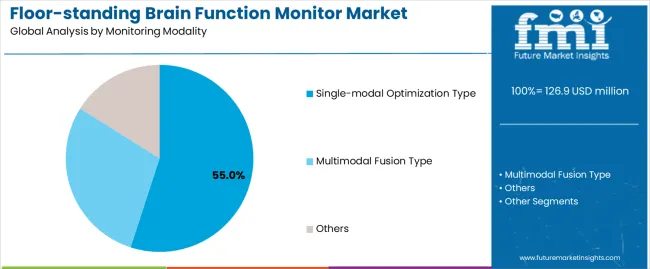
Market Position: Single-modal optimization systems command the leading position in the Floor-standing Brain Function Monitor market with approximately 55% market share through advanced monitoring properties, including superior signal clarity, reliable diagnostic capability, and operational optimization that enable healthcare providers to achieve optimal precision across diverse clinical and surgical environments.
Value Drivers: The segment benefits from clinician preference for reliable monitoring systems that provide consistent diagnostic performance, reduced assessment errors, and equipment compatibility without requiring significant facility modifications. Advanced modality features enable automated clinical integration systems, monitoring consistency, and compatibility with existing medical equipment, where system performance and diagnostic reliability represent critical operational requirements.
Competitive Advantages: Single-modal optimization systems differentiate through proven accuracy standards, consistent signal characteristics, and integration with automated monitoring systems that enhance clinical effectiveness while maintaining optimal precision suitable for diverse neurological applications.
Key market characteristics:
Multimodal fusion systems maintain specialized positioning in the Floor-standing Brain Function Monitor market with approximately 38% market share due to their comprehensive assessment properties and diagnostic integration advantages. These systems appeal to healthcare providers requiring combined monitoring modalities with superior performance for complex neurological applications. Market adoption is driven by advanced clinical facility expansion, emphasizing comprehensive diagnostic solutions and operational sophistication through optimized multimodal integration systems while maintaining superior clinical effectiveness standards.

Market Context: Clinical diagnosis applications dominate the Floor-standing Brain Function Monitor market with approximately 60% market share due to widespread adoption of neurological monitoring systems and increasing focus on diagnostic precision, assessment optimization, and patient evaluation applications that minimize diagnostic errors while maintaining healthcare standards.
Appeal Factors: Clinical facilities prioritize monitoring reliability, diagnostic consistency, and integration with existing healthcare infrastructure that enables coordinated assessment application across multiple patient care pathways. The segment benefits from substantial healthcare investment and neurological care programs that emphasize the acquisition of brain monitors for precision diagnosis and clinical decision-making applications.
Growth Drivers: Neurological disorder prevalence expansion programs incorporate floor-standing brain function monitors as standard equipment for clinical operations, while diagnostic quality requirements increase demand for precision monitoring capabilities that comply with healthcare standards and minimize assessment variations.
Market Challenges: Varying healthcare standards and clinical protocol differences may limit monitoring standardization across different medical facilities or operational scenarios.
Application dynamics include:
Intraoperative monitoring applications capture approximately 35% market share through specialized assessment requirements in neurosurgical operations, spinal procedures, and complex surgical applications. These facilities demand robust monitoring systems capable of real-time neurological assessment while providing accurate functional evaluation and surgical guidance capabilities.
Other applications account for approximately 5% market share, including neurological research, academic medical centers, and specialized clinical investigation applications requiring brain monitoring capabilities for research protocols and experimental assessment.
Growth Accelerators: Neurological disease prevalence expansion drives primary adoption as floor-standing brain function monitors provide superior diagnostic capabilities that enable healthcare facilities to meet stringent clinical standards without excessive equipment costs, supporting patient care operations and medical missions that require precise neurological assessment applications. Healthcare infrastructure demand accelerates market expansion as medical facilities seek effective precision systems that minimize diagnostic errors while maintaining clinical effectiveness during patient evaluation and surgical monitoring scenarios. Healthcare spending increases worldwide, creating sustained demand for monitoring systems that complement traditional diagnostic processes and provide clinical optimization in competitive healthcare markets.
Growth Inhibitors: Equipment investment challenges vary across device suppliers regarding the sourcing of specialized sensors and signal processing components, which may limit operational flexibility and market penetration in regions with budget constraints or cost-sensitive healthcare operations. Technical performance limitations persist regarding patient interface considerations and monitoring complexity that may reduce effectiveness in emergency, pediatric, or resource-limited clinical conditions, affecting monitoring versatility and application requirements. Market fragmentation across multiple healthcare standards and clinical protocols creates compatibility concerns between different monitoring suppliers and existing facility infrastructure.
Market Evolution Patterns: Adoption accelerates in neurology and neurosurgery sectors where diagnostic precision justifies monitoring system costs, with geographic concentration in developed markets transitioning toward mainstream adoption in emerging economies driven by healthcare expansion and neurological awareness. Technology development focuses on enhanced monitoring formulations, improved clinical integration, and compatibility with electronic health record systems that optimize diagnostic accuracy and clinical effectiveness. The market could face disruption if alternative neurological assessment technologies or portable monitoring innovations significantly limit the deployment of floor-standing systems in clinical applications, though floor-standing brain function monitors' unique combination of comprehensive assessment, stability, and diagnostic reliability continues to make them preferred in specialized neurological applications.
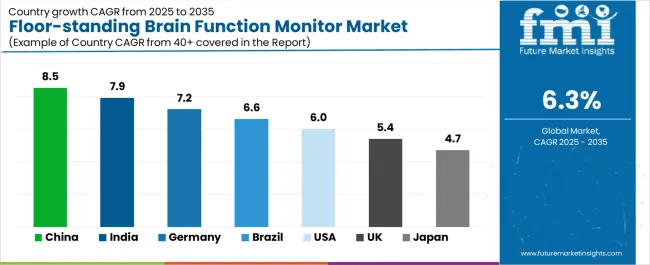
The Floor-standing Brain Function Monitor market demonstrates varied regional dynamics with Growth Leaders including China (8.5% CAGR) and India (7.9% CAGR) driving expansion through healthcare capacity additions and neurological care programs. Steady Performers encompass Germany (7.2% CAGR), Brazil (6.6% CAGR), and United States (6% CAGR), benefiting from established healthcare infrastructure and advanced diagnostic adoption. Mature Markets feature United Kingdom (5.4% CAGR) and Japan (4.7% CAGR), where specialized neurological applications and precision monitoring integration support consistent growth patterns.
| Country | CAGR (2025-2035) |
|---|---|
| China | 8.5% |
| India | 7.9% |
| Germany | 7.2% |
| Brazil | 6.6% |
| United States | 6% |
| United Kingdom | 5.4% |
| Japan | 4.7% |
Regional synthesis reveals Asia Pacific markets leading adoption through healthcare expansion and neurological care infrastructure development, while European countries maintain steady expansion supported by precision monitoring technology advancement and clinical standardization requirements. North American markets show moderate growth driven by neurosurgical applications and clinical integration trends.
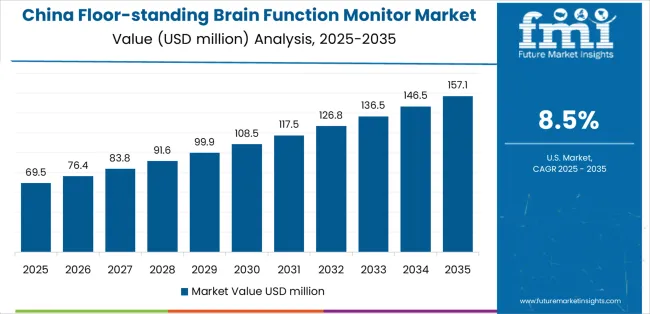
The Chinese market emphasizes advanced monitoring features, including precision diagnostic control and integration with comprehensive healthcare platforms that manage patient assessment, clinical optimization, and neurological evaluation applications through unified monitoring systems. The country demonstrates strong growth at 8.5% CAGR, driven by healthcare infrastructure expansion, neurological care initiatives, and emerging hospital development that support brain monitor integration. Chinese healthcare providers prioritize clinical effectiveness with floor-standing brain function monitors delivering consistent diagnostic performance through advanced monitoring capabilities and clinical adaptation features.
Technology deployment channels include major hospital facilities, specialized medical device suppliers, and healthcare procurement programs that support professional applications for complex neurological monitoring and surgical assessment applications. Healthcare platform integration capabilities with established hospital systems expand market appeal across diverse clinical requirements seeking diagnostic precision and automation benefits. The expanding healthcare base and accelerating neurology sector create sustained demand, while innovative applications in comprehensive diagnostic centers and specialized neurosurgical facilities open new growth avenues.
Performance Metrics:
Germany's advanced healthcare market demonstrates sophisticated brain monitor deployment with documented clinical effectiveness in neurological diagnostic applications and neurosurgical facilities through integration with existing monitoring systems and clinical infrastructure. The country leverages medical expertise in precision diagnostics and healthcare systems integration to maintain strong growth at 7.2% CAGR. Healthcare centers, including Berlin, Munich, and Hamburg, showcase precision installations where brain monitor systems integrate with comprehensive clinical platforms and patient management systems to optimize diagnostic operations and monitoring effectiveness.
German healthcare providers prioritize system precision and clinical compliance in monitor development, creating demand for advanced monitoring systems with superior features, including automated integration and quality assurance systems. The market benefits from established healthcare infrastructure and a willingness to invest in precision diagnostic technologies that provide long-term clinical benefits and compliance with international healthcare and quality standards.
Market Intelligence Brief:
The USA healthcare brain monitor market demonstrates sophisticated deployment across neurological applications with documented effectiveness in diagnostic assessment and surgical monitoring facilities through integration with comprehensive clinical systems and quality control infrastructure. The country leverages advanced healthcare capabilities in clinical innovation and diagnostic technologies to maintain moderate growth at 6% CAGR. Medical centers, including Boston, New York, and Los Angeles, showcase advanced installations where brain monitor systems integrate with comprehensive healthcare platforms and hospital management networks to optimize clinical efficiency and diagnostic accuracy.
American healthcare providers prioritize clinical innovation and diagnostic precision in monitor development, creating demand for advanced monitoring systems with superior features, including electronic health record integration and automated analysis systems. The market benefits from established healthcare infrastructure and willingness to invest in innovation technologies that provide long-term clinical benefits and compliance with FDA and healthcare standards.
Market Intelligence Brief:
The UK healthcare brain monitor market demonstrates advanced quality deployment with documented clinical effectiveness in neurological diagnostic applications and surgical facilities through integration with existing quality systems and clinical infrastructure. The country leverages regulatory expertise in healthcare standards and clinical systems integration to maintain steady growth at 5.4% CAGR. Medical centers, including London, Manchester, and Edinburgh, showcase precision installations where brain monitor systems integrate with comprehensive quality platforms and patient care systems to optimize clinical compliance and monitoring effectiveness.
British healthcare providers prioritize system quality and regulatory compliance in monitor development, creating demand for certified monitoring systems with advanced features, including traceability tracking and quality integration. The market benefits from established healthcare infrastructure and commitment to invest in quality technologies that provide long-term clinical benefits and compliance with UK and NHS healthcare standards. Neurological applications, neurosurgical systems, and diagnostic programs drive diversified demand across multiple clinical segments.
Strategic Market Indicators:
India's healthcare brain monitor market demonstrates rapid expansion deployment with documented clinical effectiveness in neurological diagnostic applications and hospital facilities through integration with emerging healthcare systems and clinical infrastructure. The country leverages growing healthcare capabilities in medical technology and clinical systems integration to achieve high growth at 7.9% CAGR. Medical centers, including Mumbai, Delhi, and Bangalore, showcase expanding installations where brain monitor systems integrate with comprehensive healthcare platforms and hospital networks to optimize market penetration and clinical effectiveness.
Indian healthcare providers prioritize diagnostic precision and clinical standards in monitor development, creating demand for reliable monitoring systems with advanced features, including automated integration and quality control systems. The market benefits from expanding healthcare infrastructure and willingness to invest in international-standard diagnostic technologies that provide clinical optimization and compliance with global healthcare standards.
Market Intelligence Brief:
Japan's healthcare brain monitor market demonstrates precision deployment with documented clinical effectiveness in advanced neurological diagnostic applications and specialized medical facilities through integration with sophisticated clinical systems and quality infrastructure. The country leverages medical excellence in precision diagnostics and healthcare systems integration to maintain steady growth at 4.7% CAGR. Medical centers, including Tokyo, Osaka, and Yokohama, showcase precision installations where brain monitor systems integrate with comprehensive quality platforms and clinical management systems to optimize diagnostic excellence and monitoring effectiveness.
Japanese healthcare providers prioritize system precision and clinical excellence in monitor development, creating demand for ultra-precision monitoring systems with advanced features, including micro-signal measurement capabilities and quality integration systems. The market benefits from established healthcare infrastructure and commitment to invest in highest-quality diagnostic technologies that provide superior clinical performance and compliance with stringent Japanese healthcare standards.
Strategic Market Indicators:
Brazil's healthcare brain monitor market demonstrates expanding deployment with documented clinical effectiveness in neurological diagnostic applications and hospital facilities through integration with developing healthcare systems and clinical infrastructure. The country leverages healthcare growth capabilities in medical expansion and clinical systems development to achieve growth at 6.6% CAGR. Medical centers, including Sao Paulo, Rio de Janeiro, and Brasilia, showcase growing installations where brain monitor systems integrate with healthcare platforms and hospital operations to optimize medical development and clinical effectiveness.
Brazilian healthcare providers prioritize clinical reliability and cost-effectiveness in monitor development, creating demand for durable monitoring systems with practical features, including clinical integration and quality monitoring systems. The market benefits from expanding healthcare infrastructure and investment in medical technologies that provide clinical improvement and compliance with emerging healthcare standards.
Market Intelligence Brief:
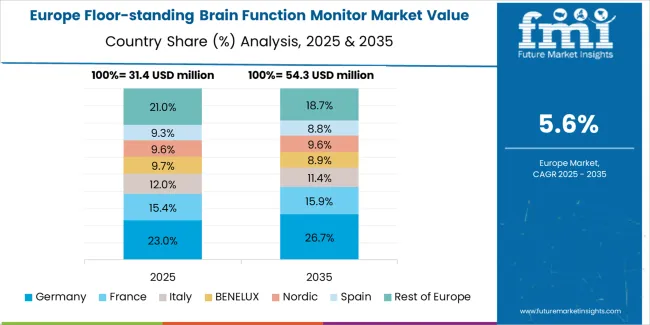
The floor-standing brain function monitor market in Europe is projected to grow substantially over the forecast period, with Germany expected to maintain its leadership position with a significant market share supported by its advanced healthcare infrastructure and major medical centers in Berlin and Munich. United Kingdom follows with strong market presence, driven by comprehensive neurological care programs and precision diagnostic initiatives. France holds substantial market share through specialized neurology activities, clinical diagnostic applications, and hospital expansion. Italy commands notable market presence through strong neurosurgical and diagnostic projects. Spain accounts for growing market share aided by healthcare expansion and neurological care adoption. The Netherlands maintains steady share driven by specialty diagnostic applications and hospital automation demand. The Rest of Europe region is anticipated to show steady adoption, reflecting consistent growth in Nordic countries, healthcare expansion in Central European markets, and clinical upgrades across Eastern European medical facilities.

In Japan, the Floor-standing Brain Function Monitor market prioritizes single-modal optimization systems, which capture the dominant share of neurological diagnostic and clinical installations due to their advanced features, including precision signal processing optimization and seamless integration with existing healthcare infrastructure. Japanese healthcare providers emphasize reliability, precision, and long-term clinical excellence, creating demand for single-modal optimization systems that provide consistent monitoring capabilities and superior diagnostic performance based on clinical requirements and quality standards. Multimodal fusion maintains secondary positions primarily in specialized neurosurgical applications and research installations where comprehensive monitoring functionality meets operational requirements without compromising diagnostic accuracy.
Market Characteristics:
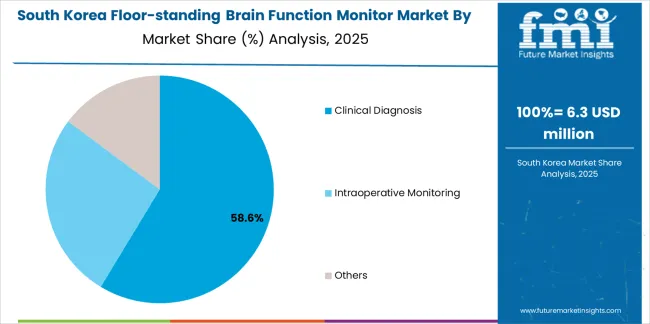
In South Korea, the market structure favors international medical device manufacturers, including Natus, Medicom MTD Ltd, and NeuroWave Systems Inc., which maintain dominant positions through comprehensive product portfolios and established healthcare networks supporting both clinical diagnostic monitoring and surgical assessment installations. These providers offer integrated solutions combining advanced brain monitor systems with professional calibration services and ongoing technical support that appeal to Korean hospitals seeking reliable precision monitoring systems. Local medical equipment distributors and healthcare service providers capture moderate market share by providing localized service capabilities and competitive pricing for standard monitoring installations, while domestic manufacturers focus on specialized applications and cost-effective solutions tailored to Korean healthcare market characteristics.
Channel Insights:

The floor-standing brain function monitor market operates with moderate concentration, featuring approximately 14-16 meaningful participants, where leading companies control roughly 40-45% of the global market share through established healthcare relationships and comprehensive medical device portfolios. Competition emphasizes advanced diagnostic capabilities, system reliability, and clinical integration rather than price-based rivalry. The leading company, Natus, commands approximately 18% market share through its extensive neurological monitoring product line and global healthcare presence.
Market Leaders encompass Natus, Medicom MTD Ltd, and NeuroWave Systems Inc., which maintain competitive advantages through extensive neurological monitoring expertise, global healthcare networks, and comprehensive clinical integration capabilities that create customer loyalty and support premium pricing. These companies leverage decades of brain monitoring experience and ongoing innovation investments to develop advanced monitoring systems with precision diagnostic control and quality features. Technology Innovators include Neurosoft, Cadwell Industries, and Nihon Kohden Corporation, which compete through specialized monitoring technology focus and innovative diagnostic capabilities that appeal to healthcare providers seeking advanced neurological solutions and clinical differentiation.
These companies differentiate through rapid product development cycles and specialized clinical application focus. Regional Specialists feature medical device manufacturers focusing on specific geographic markets and specialized applications, including automated monitoring systems and integrated clinical solutions. Market dynamics favor participants that combine reliable diagnostic formulations with advanced clinical capabilities, including precision signal processing and quality optimization features. Competitive pressure intensifies as traditional medical device suppliers expand into neurological monitoring systems, while specialized diagnostic companies challenge established players through innovative precision solutions and automated platforms targeting clinical diagnosis and intraoperative monitoring segments.
| Item | Value |
|---|---|
| Quantitative Units | USD 126.9 million |
| Monitoring Modality | Single-modal Optimization Type, Multimodal Fusion Type, Others |
| Application | Clinical Diagnosis, Intraoperative Monitoring, Others |
| Regions Covered | Asia Pacific, Europe, North America, Latin America, Middle East & Africa |
| Countries Covered | China, India, Germany, Brazil, United States, United Kingdom, Japan, and 20+ additional countries |
| Key Companies Profiled | Natus, Medicom MTD Ltd, NeuroWave Systems Inc., Neurosoft, Cadwell Industries, Nihon Kohden Corporation, GE HealthCare, Inomed, Deymed Diagnostic, EMS Handels Gesellschaft mbH, Accurate Monitoring, NeuroMonitoring Technologies, Inc, Sentient Medical Systems, Shenzhen Yingchi Technology Co., Ltd. |
| Additional Attributes | Dollar sales by monitoring modality and application categories, regional adoption trends across Asia Pacific, Europe, and North America, competitive landscape with medical device manufacturers and healthcare suppliers, healthcare provider preferences for precision and clinical reliability, integration with hospital platforms and patient monitoring systems, innovations in automated diagnostic formulations and monitoring excellence, and development of clinical solutions with enhanced performance and diagnostic optimization capabilities. |
The global floor-standing brain function monitor market is estimated to be valued at USD 126.9 million in 2025.
The market size for the floor-standing brain function monitor market is projected to reach USD 233.8 million by 2035.
The floor-standing brain function monitor market is expected to grow at a 6.3% CAGR between 2025 and 2035.
The key product types in floor-standing brain function monitor market are single-modal optimization type, multimodal fusion type and others.
In terms of application, clinical diagnosis segment to command 60.0% share in the floor-standing brain function monitor market in 2025.






Our Research Products

The "Full Research Suite" delivers actionable market intel, deep dives on markets or technologies, so clients act faster, cut risk, and unlock growth.

The Leaderboard benchmarks and ranks top vendors, classifying them as Established Leaders, Leading Challengers, or Disruptors & Challengers.

Locates where complements amplify value and substitutes erode it, forecasting net impact by horizon

We deliver granular, decision-grade intel: market sizing, 5-year forecasts, pricing, adoption, usage, revenue, and operational KPIs—plus competitor tracking, regulation, and value chains—across 60 countries broadly.

Spot the shifts before they hit your P&L. We track inflection points, adoption curves, pricing moves, and ecosystem plays to show where demand is heading, why it is changing, and what to do next across high-growth markets and disruptive tech

Real-time reads of user behavior. We track shifting priorities, perceptions of today’s and next-gen services, and provider experience, then pace how fast tech moves from trial to adoption, blending buyer, consumer, and channel inputs with social signals (#WhySwitch, #UX).

Partner with our analyst team to build a custom report designed around your business priorities. From analysing market trends to assessing competitors or crafting bespoke datasets, we tailor insights to your needs.
Supplier Intelligence
Discovery & Profiling
Capacity & Footprint
Performance & Risk
Compliance & Governance
Commercial Readiness
Who Supplies Whom
Scorecards & Shortlists
Playbooks & Docs
Category Intelligence
Definition & Scope
Demand & Use Cases
Cost Drivers
Market Structure
Supply Chain Map
Trade & Policy
Operating Norms
Deliverables
Buyer Intelligence
Account Basics
Spend & Scope
Procurement Model
Vendor Requirements
Terms & Policies
Entry Strategy
Pain Points & Triggers
Outputs
Pricing Analysis
Benchmarks
Trends
Should-Cost
Indexation
Landed Cost
Commercial Terms
Deliverables
Brand Analysis
Positioning & Value Prop
Share & Presence
Customer Evidence
Go-to-Market
Digital & Reputation
Compliance & Trust
KPIs & Gaps
Outputs
Full Research Suite comprises of:
Market outlook & trends analysis
Interviews & case studies
Strategic recommendations
Vendor profiles & capabilities analysis
5-year forecasts
8 regions and 60+ country-level data splits
Market segment data splits
12 months of continuous data updates
DELIVERED AS:
PDF EXCEL ONLINE
Brain Fitness Market Size and Share Forecast Outlook 2025 to 2035
Brain Computing Interfaces Market Size and Share Forecast Outlook 2025 to 2035
Brain Cancer Diagnostics Market Size and Share Forecast Outlook 2025 to 2035
Brain Metastasis Therapeutics Market Analysis - Size, Share, and Forecast Outlook 2025 to 2035
Brain-Computer Interface Implant Market Analysis Size and Share Forecast Outlook 2025 to 2035
Brain Implants Market Size and Share Forecast Outlook 2025 to 2035
Brain Imaging and Neuroimaging Market Size and Share Forecast Outlook 2025 to 2035
Brain Health Supplement Market Analysis - Size, Share, and Forecast Outlook 2025 to 2035
Brain Tumor Treatment Market Analysis-- Size and Share Forecast Outlook 2025 to 2035
Brain Biomarker Market Trends and Forecast 2025 to 2035
Brain Tumor Drugs Market Forecast & Analysis: 2025 to 2035
Brain Mint Market Analysis by Functionality, Consumer Orientation, Sales Channel and Region Through 2035
Brain Fingerprinting Technology Market
Brain Monitoring Market Size and Share Forecast Outlook 2025 to 2035
Brain Monitoring Systems Market is segmented by Lateral Flow Readers and Kits and Reagents from 2025 to 2035
Deep Brain Stimulator Market Size and Share Forecast Outlook 2025 to 2035
Kids’ Brain Health Supplements Market Size and Share Forecast Outlook 2025 to 2035
Bovine Brain Extract Size and Share Forecast Outlook 2025 to 2035
Chronic Brain Damage Treatment: Trends, Growth, and Key Developments
Auditory Brainstem Response Analyzers Market Size and Share Forecast Outlook 2025 to 2035

Thank you!
You will receive an email from our Business Development Manager. Please be sure to check your SPAM/JUNK folder too.
Chat With
MaRIA